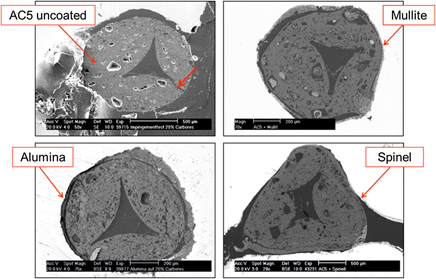Crossref Citations
This article has been cited by the following publications. This list is generated based on data provided by
Crossref.
Emmel, Marcus
Aneziris, Christos G.
Sponza, Francesco
Dudczig, Steffen
and
Colombo, Paolo
2014.
In situ spinel formation in Al2O3–MgO–C filter materials for steel melt filtration.
Ceramics International,
Vol. 40,
Issue. 8,
p.
13507.
Soltysiak, S.
Abendroth, M.
Kuna, M.
Klemm, Y.
and
Biermann, H.
2014.
Strength of fine grained carbon-bonded alumina (Al2O3–C) materials obtained by means of the small punch test.
Ceramics International,
Vol. 40,
Issue. 7,
p.
9555.
Dudczig, S.
Aneziris, C.G.
Emmel, M.
Schmidt, G.
Hubalkova, J.
and
Berek, H.
2014.
Characterization of carbon-bonded alumina filters with active or reactive coatings in a steel casting simulator.
Ceramics International,
Vol. 40,
Issue. 10,
p.
16727.
Zienert, Tilo
and
Fabrichnaya, Olga
2015.
Interface reactions between steel 42CrMo4 and mullite.
Journal of the European Ceramic Society,
Vol. 35,
Issue. 4,
p.
1317.
Storti, Enrico
Emmel, Marcus
Dudczig, Steffen
Colombo, Paolo
and
Aneziris, Christos G.
2015.
Development of multi-walled carbon nanotubes-based coatings on carbon-bonded alumina filters for steel melt filtration.
Journal of the European Ceramic Society,
Vol. 35,
Issue. 5,
p.
1569.
Storti, Enrico
Dudczig, Steffen
Emmel, Marcus
Colombo, Paolo
and
Aneziris, Christos G.
2016.
Functional Coatings on Carbon‐Bonded Ceramic Foam Filters for Steel Melt Filtration.
steel research international,
Vol. 87,
Issue. 8,
p.
1030.
Weidner, Anja
Krewerth, Dominik
Witschel, Birgit
Emmel, Marcus
Schmidt, Anne
Gleinig, Johannes
Volkova, Olena
Aneziris, Christos G.
and
Biermann, Horst
2016.
Microstructure of Non‐Metallic Inclusions Identified in Cast Steel 42CrMo4 after Metal Melt Filtration by Novel Foam Filters.
steel research international,
Vol. 87,
Issue. 8,
p.
1038.
Storti, Enrico
Dudczig, Steffen
Schmidt, Anne
Schmidt, Gert
and
Aneziris, Christos G.
2017.
Filter Functionalization with Carbon Nanotubes and Alumina Nanosheets for Advanced Steel Filtration.
steel research international,
Vol. 88,
Issue. 10,
p.
1700142.
Storti, Enrico
Dudczig, Steffen
Hubálková, Jana
Gleinig, Johannes
Weidner, Anja
Biermann, Horst
and
Aneziris, Christos G.
2017.
Impact of Nanoengineered Surfaces of Carbon‐Bonded Alumina Filters on Steel Cleanliness .
Advanced Engineering Materials,
Vol. 19,
Issue. 9,
Schmidt, Anne
Salomon, Anton
Dudczig, Steffen
Berek, Harry
Rafaja, David
and
Aneziris, Christos G.
2017.
Functionalized Carbon‐Bonded Filters with an Open Porous Alumina Coating: Impact of Time on Interactions and Steel Cleanliness .
Advanced Engineering Materials,
Vol. 19,
Issue. 9,
Luchini, B.
Hubálková, J.
Wetzig, T.
Grabenhorst, J.
Fruhstorfer, J.
Pandolfelli, V.C.
and
Aneziris, C.G.
2018.
Carbon-bonded alumina foam filters produced by centrifugation: A route towards improved homogeneity.
Ceramics International,
Vol. 44,
Issue. 12,
p.
13832.
Gehre, Patrick
Schmidt, Anne
Dudczig, Steffen
Hubálková, Jana
Aneziris, Christos G.
Child, Nick
Delaney, Ian
Rancoule, Gilbert
and
DeBastiani, Duane
2018.
Interaction of slip‐ and flame‐spray coated carbon‐bonded alumina filters with steel melts.
Journal of the American Ceramic Society,
Vol. 101,
Issue. 7,
p.
3222.
Jankovský, Ondřej
Storti, Enrico
Schmidt, Gert
Dudczig, Steffen
Sofer, Zdeněk
and
Aneziris, Christos G.
2018.
Unique wettability phenomenon of carbon-bonded alumina with advanced nanocoating.
Applied Materials Today,
Vol. 13,
Issue. ,
p.
24.
Schramm, Alina
Bock, Benjamin
Schmidt, Anne
Zienert, Tilo
Ditze, André
Scharf, Christiane
and
Aneziris, Christos G.
2018.
Interface reactions of differently coated carbon-bonded alumina filters with an AZ91 magnesium alloy melt.
Ceramics International,
Vol. 44,
Issue. 14,
p.
17415.
Wu, Wei
Lesher, Matthew G.
Hu, Chuntian
Shvedova, Khrystyna
Takizawa, Bayan
O’Connor, Thomas F.
Yang, Xiaochuan
Ramanujam, Sukumar
and
Mascia, Salvatore
2018.
Development of an Automated Continuous Clarification Bypass System To Remove Suspended Particulate Matter.
Organic Process Research & Development,
Vol. 22,
Issue. 9,
p.
1214.
Storti, Enrico
Berek, Harry
and
Aneziris, Christos G.
2018.
Focused ion beam preparation and microscopy investigation of secondary layer on carbon-bonded alumina filter after steel contact.
Ceramics International,
Vol. 44,
Issue. 12,
p.
14502.
Himcinschi, C.
Biermann, C.
Storti, E.
Dietrich, B.
Wolf, G.
Kortus, J.
and
Aneziris, C.G.
2018.
Innovative carbon-bonded filters based on a new environmental-friendly binder system for steel melt filtration.
Journal of the European Ceramic Society,
Vol. 38,
Issue. 16,
p.
5580.
Gleinig, Johannes
Weidner, Anja
Fruhstorfer, Jens
Aneziris, Christos G.
Volkova, Olena
and
Biermann, Horst
2019.
Characterization of Nonmetallic Inclusions in 18CrNiMo7-6.
Metallurgical and Materials Transactions B,
Vol. 50,
Issue. 1,
p.
337.
Bock, Benjamin
Schmidt, Anne
Sniezek, Edyta
Dudczig, Steffen
Schmidt, Gert
Szczerba, Jacek
and
Aneziris, Christos G.
2019.
Impact of spinel forming systems (Fe-/Mg-/Mn-Al-O) as functional coating materials for carbon-bonded alumina filters on steel melt filtration.
Ceramics International,
Vol. 45,
Issue. 4,
p.
4499.
Neumann, Marc
Wetzig, Tony
Fruhstorfer, Jens
Lampert, Vicky
Jelitto, Hans
Schneider, Gerold A.
and
Aneziris, Christos G.
2020.
Crack propagation behaviour of carbon free and carbon bonded alumina based filter materials.
Ceramics International,
Vol. 46,
Issue. 8,
p.
11198.





